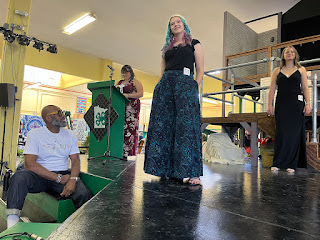By Marisa Coyne & Becky Harrington
While some trend forecasters attend Paris Fashion Week and others comb Instagram metadata to spot the next big thing, leaders of volunteers look to academic papers, industry reports, and conference proceedings to understand the changing needs and demands of current and prospective volunteers. Volunteer scholars suggest that, in order for youth developers and other leaders of volunteers to build strong and sustainable volunteer systems, they need to question dominant norms and delivery models and adapt accordingly. In this season of trend forecasting, we share what’s 'in' in volunteer engagement.
Trend #1: Intention to volunteer is high … so is overwhelm
US respondents to a pandemic-era volunteerism survey reported record-high intention to volunteer. At the same time, people living in the US are experiencing record-high stress and overwhelm. Youth-serving organizations who work with volunteers to deliver programs should establish volunteer recruitment plans that include strategies that engage new volunteers and re-engage volunteers whose participation has waned.
- Use a customer-service approach in volunteer communications. Ensure that internal and external organizational messaging related to volunteer recruitment and renewal recognize that volunteers have a choice about where they spend their time and that their service is highly valued.
- Have hard to fill volunteer roles? Consider engaging multiple volunteers to take ownership of tasks, rather than roles. Use existing volunteer role descriptions to identify discrete tasks ready for delegation. Federal datasets indicate that informal and formal volunteer service is positively correlated. Engaging new or low-commitment volunteers in discrete, time limited tasks may result in a willingness to accept a more formal role.
- Create and maintain a volunteer interest form for local, statewide volunteer recruitment. Document contact information for program 'supporters' or 'helpers' who have not yet made the choice to become a screened and approved volunteer.
- Implement both formal and informal volunteer recognition practices to sustain and improve volunteer retention. See Equity-informed volunteer recognition: Three shifts in practice for more on this topic.
Trend #2: Communicating volunteer impact can improve volunteer and community engagement
Recent volunteerism research finds that volunteerism in youth-serving organzations results in personal, organizational, and public value impacts of that volunteerism. Generational research suggests that Millennial and Gen Z age cohorts, the largest and most diverse generations in terms of race, ethnicity, and gender, are strongly motivated by a desire to positively impact their communities. Youth developers with responsibility for leading and managing volunteers should regularly communicate the personal, organizational and public impacts that volunteers make in order to improve volunteer and community engagement
- Understand and name the personal, organizational and public impact of volunteering with youth-serving programs.
- List benefits volunteers are likely to receive in recruitment materials, including volunteer role descriptions. Train volunteers in program evaluation and impact reporting.
- Speak the language of impact.
- Use impact statements when recognizing volunteers.
- Provide time for feedback at the end of volunteer service.
- Communicate to stakeholders how volunteers contribute to the mission of your organization and to public value.
Trend #3: Volunteers demand accountability for DEIA in organizational policy, practice
Volunteers and prospective volunteers are increasingly interested in programmatic accountability for Diversity Equity Inclusion and Access (DEIA) goals and objectives. Volunteers from groups that have been historically excluded and marginalized, have long assessed an organization’s commitment to equity before affiliating. Now, volunteers from millennial and Gen Z, the most diverse age cohorts in terms of race, ethnicity, and gender, are paying attention. Leaders of volunteers should respond to this demand by setting, communicating, and ensuring fidelity to DEIA goals and objectives while also engaging in personal development to increase cultural awareness and competency.
- Familiarize yourself with policy, environmental, and system change work being done to advance equity within your organization and community.
- Include DEIA-related objectives in your program plan and personal plan of work. Invite feedback from colleagues with DEIA expertise.
- Use local Extension website, newsletter, blog, email, meeting announcements to share about DEIA related policy, goals, progress, etc. with volunteers (and prospective volunteers).
- Learn from volunteerism scholars and practitioners about how to eliminate barriers and build capacity to recruit, support and retain a diverse base of volunteers.
- Develop and/or promote DEIA related training and development opportunities for volunteers.
- Seek out and promote research-based materials like the Increasing Cultural Awareness & Equity in Extension Programs course (on the eXtension Campus platform) to build the capacity of current volunteers.
- Collaborate with Communications personnel to prepare responses to resistance around DEIA-related offerings.
- Implement known and knowable changes to volunteer admin processes that reduce the burden of participation especially for working volunteers, volunteers who speak English as a second language, volunteers with disabilities, Black, Indigenous and People of Color volunteers.
- Adapt volunteer codes of conduct and conflict resolution processes to distinguish between interpersonal conflict and harassment, discrimination, hate and bias.
- Embrace workarounds that move our organization toward equity.
- Review industry reports like Co-Creating Racial Equity in Volunteer Engagement from the Minnesota Alliance for Volunteer Advancement to understand and incorporate recommendations from volunteers themselves.
What struck you? What did we miss? How will you adapt to the changing needs and demands of your youth-serving organizations’ current and potential volunteers?
-- Marisa A. Coyne, Extension educator and volunteer systems director
Becky Harrington, director of operations and systems
You are welcome to comment on this blog post. We encourage civil discourse, including spirited disagreement. We will delete comments that contain profanity, pornography or hate speech--any remarks that attack or demean people because of their sex, race, ethnic group, etc.--as well as spam.

Comments
Post a Comment